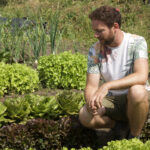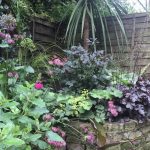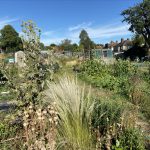I seem to be thinking about lawns more than is healthy, and I’m not the only one. I’m trying not to use the term ‘turf war’ but it feels appropriate, and everyone seems to be sticking their trowel in.
Over the last few years the lawn has come under attack, pulled one way and the other – who knew grass could be so controversial. First for being a wildlife free waste of space (not actually true, read on…), re-wild it people shouted! Leave parts or all of it to grow into a sort-of meadow with longer grass and some flowers. Then along came the successful No Mow May campaign from the charity Plantlife encouraging us all to try not-mowing our lawns at all in that month to see what happened. I’ve asked people to consider whether they really need one, or feel obliged.
The negativity around lawns has grown and grown until it now feels a tad out of hand. One of the worst outcomes of lawn negativity is that we’re at a point where thousands of companies are profiting by replacing real lawns with fake plastic lawns. “It’s better for the planet because there is no mowing or watering!” they lie (plastic grass is one of the worst things you can do for the planet).
I like the idea of No Mow May, and I’ve taken part in the past, helping insects in late-spring. However there are downsides, such as encouraging insect populations in May only to mow away many of the flowers they were relying on in June. Allowing grass to grow long in spring can also lead to clumpy grass with shaded dead patches, leading to more people hating on their lawns.
What I prefer is the longterm view. A fundamental shift in your diet instead of a fad. Plantlife’s other wonderful initiative, research showing that lawns cut slightly longer at around 10cm can significantly increase wildlife is what I’m into.
I wrote in my first book Wild about Weeds that if I ever own a lawn it would be the most weed filled, colourful lawn on the planet. Fast forward a few years and we do now indeed own a lawn and I am allowing dandelions, daisies, clover and more to spread through it. We have lots of self heal in the planting areas next to our lawn path and I’m hoping they move into the lawn too.
I’ve come to the conclusion that the lawn is actually the most sustainable usable surface humans can create. We do need usable surfaces for us to walk on, on paths, to sit on, to play games, have picnics. And a lawn has got to be better for the planet and wildlife than paving, bricks, gravel, tarmac etc.
But my definition of a lawn is not what traditionalists call a lawn. My lawn is full of daisies and dandelions, giving me colour and insects. Moss is allowed to grow, filling in the green in shady areas. I mow it on mulch mode and don’t expect to need to feed it because the clippings left on the grass will be drawn into the soil by worms and other soil life.
A living lawn is full of life below ground and in the low growing grasses. A lawn with ye olde school weeds is a large expanse of flowers. Low grass areas are important for some wildlife such as some ground nesting bees and wasps, as well as leather jackets and fungi the past gardening sector told us are nasties. They’re not nasties, they’re wonderful.
I don’t water our lawn at all, grass has evolved to go dormant in drought and bounce back when it rains again. A regularly mown lawn full of weeds is tight and resistant to heavy traffic. Turning to electric cable and battery powered mowers is the start of a greener way of cutting lawns. Not perfect, especially batteries because lithium is still a mined natural resource but certainly a step in the right direction from petrol. Of course, there are manual push mowers too.
No, the lawn is not bad, it’s in fact quite important. It beats most patios and gravels because it’s alive; alive itself and with life, actively using and storing carbon.
The answer is not to compost the lawn, it’s certainly not to turn to the environmentally harmful Astro Turf. No, it’s simply to reduce the size of the lawn to what you need, to cut a little higher, forget watering and let the flowers and fungi in. Estates with their rolling acres of lawn should probably retire some of their ride-on mowers.
Famous British green rectangles are a symbol of horticulture’s ecologically ignorant past, a reimagining of this sustainable usable surface is its future.




Thank you Jack – a commonsense approach. I have been raising the cutters on the lawn all this season and the clover, daisies and other small flowers have adapted to flowing lower so I have a flowery mead with lots of insects and bird and fewer grass cuttings !